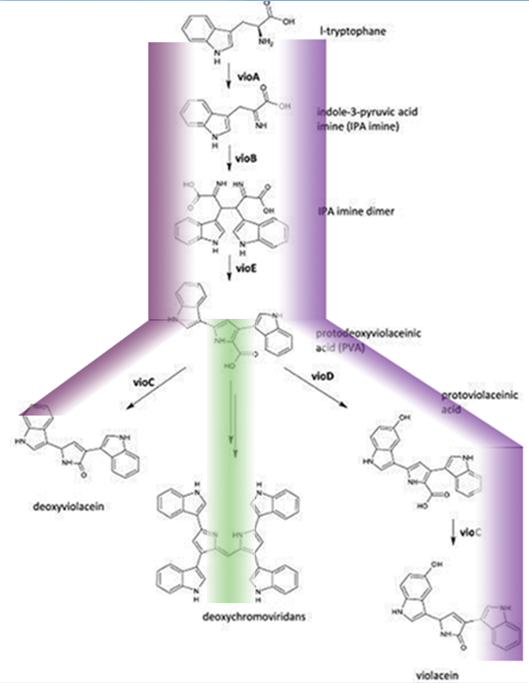Biosynthesis - Violacein
Violacein is a purple chromobacterial pigment produced from tryptophan. In its biosynthetic pathway there are 3 possible branches and 2 side products. The five key enzymes of Chromobacterium violaceum could be expressed in E.Coli through transformation and corresponding parts are available in the Registry. The Cambridge 2009 iGEM team had succesfully achieved the production of violacein.
Our membrane rudder called for a branched reaction to test its efficiency. We examined the advantages of membrane system in adjusting quantity of different products.
We modified the five vio parts and inserted them in the membrane assembly, producing a plasmid with violacein biosynthetic enzyme and light-inducing protein as well as a membrane protein. Analysis of bacteria extracts showed a satisfying decrease in side products between light-induced samples and the control group. These results demonstrate a very compromising way of using membrane rudder to switch the direction of reaction.
Background
Violacein is a pigment produced by several bacteria through pathway of 5 related genes, vioA, vioB, vioC, vioD and vioE. It was initially discovered in Chromobacterium violaceum. This metabolite of tryptophan has such special applications as antibacterial, anti-trypanocidal, anti-ulcerogenic, and anticancer drugs.
There are two interesting branches in this pathway which could be utilized in service of verification of the membrane rudder. We can identify the different end-products by means of separation, such as thin-layer chromatography (TLC), or high-performance liquid chromatography (HPLC). The product proportion change demonstrates the efficiency of alteration in reaction direction.
Violacein Biosynthetic Pathway
 Fig.1 :The violacein biosynthetic pathway. The purple line indicates the biosynthetic flux of pigment deoxyviolacein and violet. The green line indicates the the biosynthetic flux of pigment deoxychromoviridans. The violacein biosynthetic pathway includes 5 key enzymes which work in conjunction. VioA is a flavoenzyme which work together with heme protein to oxidize and dimerize tryptophen into IPA imine dimer.Then vioE induces a indole rearrangement,producing prodeoxyviolacein, also known as PVA.
One key prerequisite in the metabolic flux is that: Automatically VioA, VioB and VioE can assemble and function to produce PVA. There exists one intrinsic E.coli enzyme aids in an additional side reaction, further modifying PVA into a green pigment called deoxychromoviridans.
The last two proteins, VioC and VioD are flacin-dependent oxygenases. VioC alone transfers PVA into a purple pigment, deoxyviolacein while vio C could also act sequentially with vioD.
vioD hydroxylates 5-position indole ring, then the other 2-position indole ring is processed by VioC to create the oxindole thus producing violacein, a violet pigment most well-studied.
Design of Membrane Complex
We chose violacein mainly because of the branching feature of its pathway. As demonstrated in the picture,vioA was linked to membrane assembly 1, vio E was linked to membrane assembly 3, while vioC and vioD were linked to VIVID, the light-inducing-dimerizable protein. Then we inserted M1-vioA and VVD-vioC into pETduet, VVD-vioD and M3-vioE into pACYCduet. Since vioB and vioE normally function in dimer state, pRSFduet with rbs-vioB and rbs-vioE was also transformed into the bacterium, then all five functional enzymes could be expressed now.
//膜蛋白图片
As long as VVD is photo-induced and dimerized, they could act like magnets that pull vioC and vioD together, and thus make it easier for intermediate to undergo catalyzation of vioC and vioD.And in this case violacein should be the dominant product we expect.
Results and Discussion
Plasmids as designed has been successfully constructed and transformed into E. coli. Single clones are picked and cultured in LB(Amp+,Kan+,Cl+) overnight, then we added arabinose for induction(supplemented with 1 mM δ-aminolevulinic acid and 40 uM ammonium iron sulfate for VioB). To ensure the efficiency of membrane switch, the bacteria culture was under bluelight during induction period.
After 5h, there appeared to be visible sigments particles in the liquid. We lysated the bateria using isasteric 10% SDS followed by 20min' ultrasonication. The pigments were extrated by ethylacetate, rotovaped for 20min and then resuspended using methanol(HPLC level). Then the samples were analyzed with HPLC(Agilent Series 2000 C18 column).
MERDE= =HPLC图片还有一排小瓶子的图片
Reference
1. Balibar, C. J. and C. T. Walsh (2006). "In vitro biosynthesis of violacein from L-tryptophan by the enzymes VioA-E from Chromobacterium violaceum." Biochemistry 45(51): 15444-57.
2. Hoshino, T. "Violacein and related tryptophan metabolites produced by Chromobacterium violaceum: biosynthetic mechanism and pathway for construction of violacein core." Appl Microbiol Biotechnol 91(6): 1463-75.
3. Shrode, L. B., Z. A. Lewis, et al. (2001). "vvd is required for light adaptation of conidiation-specific genes of Neurospora crassa, but not circadian conidiation." Fungal Genet Biol 32(3): 169-81.
|  "
"
